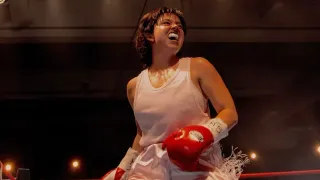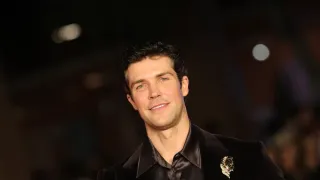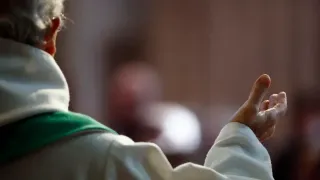May 24, 2022
Irish Ayes 'Out In The World: Ireland's LGBTQ+ Diaspora'
Brian Bromberger READ TIME: 5 MIN.
"If we don't know ourselves, how shall we ever know anyone else?" is one of the quotes featured in the new exhibit at the GLBT History Museum, "Out In The World: Ireland's LGBTQ+ Diaspora."
The exhibit formally convened on May 14 with introductory remarks from the Society's Interim Co-Executive Director Andrew Shaffer, California Senator Scott Wiener, Consul General of Ireland Robert O'Driscoll, and Irish Green Party politician Catherine Martin, who is Ireland's Minister for Tourism, Culture, Arts, Gaeltacht, Sport, and Media, followed by a reception at the Castro's Blush Wine Bar.
"Across the generations, Irish LGBTQ people have emigrated and found opportunities to live and love abroad. Yet this journey was rarely a simple transition from an oppressive island to a liberal wider world. Irish LGBTQ emigrants often faced prejudice abroad. Home, once a place of shame and silence, could also become a welcoming site of return," reads the exhibition's description.
Sponsored by EPIC, The Irish Emigration Museum, in partnership with the Irish Department of Foreign Affairs, the panel-exhibit explores six themes: exclusion, community, love, defiance, solidarity, and return, by highlighting 12 individual stories from the extensive history of Ireland's LGBTQ diaspora.
The curator is Dr. Maurice J. Casey, the gay current Department of Foreign Affairs Historian-in-Residence at EPIC, who just completed his doctorate in History at the University of Oxford in 2020. The exhibition also features artwork by Irish designer and multidisciplinary artist Richard Malone.
As outlined in Martin's launch of the exhibition, since the 1993 decriminalization of homosexuality, Irish society has undergone a major transformation. In 2015, the Irish government passed the Gender Recognition Act and the Irish public voted by a landslide for marriage equality, the first nation to do so via an election.
This exhibit, by explaining the lives of Irish LGBTQ people abroad and the contributions of those who returned, can help us understand how Ireland became such a welcoming place for Irish queer folk.
Making History
Among the personalities profiled is Michael Dillon, author of the opening quote, who was a transgender health care pioneer. While studying medicine at Trinity College Dublin, he underwent genital reconstruction surgery, becoming the first known case of a trans man to do so.
In 1946, he published "Self: A Study in Ethics and Endocrinology," which explored gender and sexual diversity. In the 1950s he worked as a surgeon with the British merchant navy. From 1955 until his death in 1962, he lived in India as a novice Buddhist monk with the name Lobzang Jivaka. The year before he died, he mailed a manuscript of his autobiography, "Out of the Ordinary," telling his story of an Anglo-Irish trans man in his own words.
Collette O'Regan, as a student at University of Oxford in the late 1980s, joined the Cork Cambodia Solidarity Group. She moved to Cambodia with Voluntary Services Overseas (VSO) in 2007. In Cambodia, she met local LGBTQ activists through her work on advocacy and equality issues. Together with Cambodian activists and other VSO volunteers, she helped organize Cambodia's first LGBTQ Pride festival in Phnom Penh in 2009. She was part of a group that founded ROCK, Rainbow Community Kampuchea, which became the first Cambodian LGBTQ organization that received official recognition from the Cambodian state.
Eva Gore-Booth was an Irish poet, labor activist and suffragist who suffered from respiratory issues, and journeyed to Italy where she fell in love with fellow English traveler Esther Roper.
They moved to England where together they edited a privately-circulated journal titled "Urania" starting in 1916. It was distributed freely to those who agreed with its aim: A society that rejected the gender binary. Their mission statement printed in each journal issue stated, "There are no 'men' or 'women' in Urania." The journal continued celebrating gender and sexual diversity until its final 1940 issue. The couple were buried in the same London plot with a line from the Greek poet Sappho engraved on their tombstone.
On April 28, 1990, a group of Irish immigrants and Irish-Americans founded the Irish Lesbian and Gay Organization (ILGO) in a Japanese restaurant in New York City. The group provided an activist home for those seeking to combine their Irish and LGBTQ identities. They led the campaign to challenge the exclusion of Irish queer people from the official New York St. Patrick's Day Parade on Fifth Avenue. When ILGO marched unsanctioned on March 16, 1991 in the parade, they faced hostility from the parade attendees. In 2016, an Irish LGBTQ group with a few old-time ILGO members was finally officially included in the parade.
There are other fascinating lives presented, such as key Irish-born activists instrumental in the success of the first ACT UP chapter in New York to advocate for People With AIDS; U.S. President Chester Arthur's grandson, who traveled to Ireland and fought for the Republicans in their 1921 Civil War; and two Irish nuns of the Franciscan Missionaries of St. Joseph who moved to Chile in the 1980s to live and work together among the poor.
All 12 portrayals are worth checking out at the exhibit, which will also include a video interviewing less famous contemporary Irish Diaspora queer folk.
The exhibition will tour select locations across the world this year, though the GLBT Historical Society Museum is the inauguration of the exhibition's run in the U.S.
"Out In The World: Ireland's LGBTQ+ Diaspora" at the GLBT History Museum, 4127 18th St. www.glbthistory.org
Help keep the Bay Area Reporter going in these tough times. To support local, independent, LGBTQ journalism, consider becoming a BAR member.






